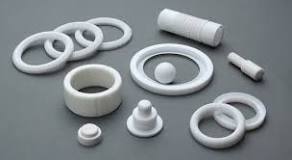PCTFE, or Polychlorotrifluoroethylene, is a unique fluoropolymer material with exceptional performance characteristics. With its excellent chemical resistance, low permeability to gases and liquids, high tensile strength, and wide temperature range tolerance, PCTFE has become a popular choice in various industries. This article will explore the advantages of PCTFE material and its versatility in different applications.

What is PCTFE?
PCTFE is a thermoplastic fluoropolymer that belongs to the family of polymers known as chlorotrifluoroethylene (ECTFE). The polymerization of chlorotrifluoroethylene monomers produces it through a process called free radical polymerization. This unique material possesses a combination of properties that make it highly desirable for many industrial applications.
Chemical Resistance
One of the critical advantages of PCTFE material is its exceptional chemical resistance. It can withstand exposure to corrosive chemicals such as acids, bases, solvents, and aggressive media like chlorine gas. This makes it an ideal choice for applications requiring contact with harsh chemicals.
Low Permeability
Another notable characteristic of PCTFE material is its extremely low permeability to gases and liquids. It exhibits one of the lowest permeation rates among all known polymers and fluoropolymers. This property makes it suitable for applications where maintaining product integrity or preventing leakage is crucial.
Mechanical Strength
PCTFE possesses excellent mechanical strength due to its high tensile strength and impact resistance. It has a higher modulus than most other fluoropolymers like polytetrafluoroethylene (PTFE) or polyvinylidene fluoride (PVDF), which allows it to withstand higher loads and pressures. This makes PCTFE a reliable choice for structural integrity and durability applications.
Wide Temperature Range Tolerance
PCTFE material exhibits exceptional thermal stability over a wide temperature range. It can withstand temperatures as low as -200°C (-328°F) and as high as 150°C (302°F) without losing its mechanical or chemical properties. This wide temperature range tolerance suits it for extreme environments where other materials may fail.
Versatility of PCTFE Fluoropolymer Material
PCTFE’s unique combination of properties makes it an extremely versatile material with applications across various industries. Let’s explore some of the common areas where PCTFE finds extensive use:
Aerospace Industry
PCTFE is widely utilized in the aerospace industry due to its exceptional chemical resistance, low outgassing properties, and ability to withstand extreme temperatures. It is used in critical components such as seals, gaskets, O-rings, valves, and electrical connectors. The high performance and reliability of PCTFE make it an essential material for ensuring safety and longevity in aerospace applications.
Pharmaceutical Industry
The pharmaceutical industry requires materials that maintain product purity while withstanding exposure to aggressive chemicals during manufacturing processes. PCTFE’s excellent chemical resistance, low permeability, and biocompatibility make it an ideal choice for pharmaceutical equipment such as tubing systems, pumps, valves, and containers.
Oil & Gas Industry
In the oil and gas industry, where corrosive fluids are prevalent along with high-pressure environments, PCTFE has proven to be highly effective due to its superior chemical resistance properties. It is used in various applications, including seals for wellheads and valves, pipe lining systems, and handling corrosive fluids like acids or brines.
Electrical Industry
PCTFE’s excellent electrical insulation properties make it suitable for use in the electrical industry. It is commonly used in cable insulation coatings because it can withstand high voltages and maintain electrical integrity. Also, PCTFE is used in connectors, switches, and other electronic components where reliable electrical insulation is required.
Cryogenic Applications
With its ability to handle extremely low temperatures without losing its mechanical properties, PCTFE finds extensive use in cryogenic applications. It is used to construct cryogenic storage tanks, valves, seals, and gaskets for handling liquefied gases like nitrogen or oxygen. The low permeability of PCTFE ensures minimal gas loss during storage or transportation.
PCTFE material offers many advantages due to its exceptional chemical resistance, low permeability, mechanical strength, and wide temperature range tolerance. Its versatility makes it an excellent choice for various industries, including aerospace, pharmaceuticals, oil and gas, electrical engineering, and cryogenic applications. With its unique combination of properties and ability to withstand harsh environments while maintaining the integrity of products or systems it uses, PCTFE remains a preferred choice for critical applications where reliability is paramount.
Frequently Asked Questions (FAQs)
Q1: Is PCTFE similar to PTFE?
A1: While PCTFE and PTFE are fluoropolymers with excellent chemical resistance properties, they differ in mechanical strength and temperature range tolerance. Unlike PTFE, which has a lower modulus and limited temperature range (-200°C to +260°C), PCTFE possesses higher tensile strength and a more comprehensive temperature range (-200°C to +150°C).
Q2: Can I use PCTFE material for food-grade applications?
A2: Yes! Due to its excellent chemical resistance and low permeability properties, PCTFE is considered safe for food contact applications. It complies with various food regulatory standards, such as FDA regulations.
Q3: Are there any limitations or drawbacks of using PCTFE?
A3: While highly versatile, it’s important to note that the manufacturing process of specific complex shapes using pure solid-state techniques can be challenging due to the high melting point of the material. However, this limitation can be overcome by utilizing molding techniques.
Q4: How does the cost compare between fluoropolymers like PTFE and FEP?
A4: Due to its unique combination of performance characteristics, exceptional chemical resistance properties, and superior mechanical strength compared to other fluoropolymers, PCTFE tends to be more expensive than PTFE or FEP.
Q5: Can PCTFE withstand radiation exposure?
A5: Yes, PCTFE fluoropolymer material exhibits good resistance to radiation and can withstand exposure to ionizing radiation without significantly degrading its physical properties. This makes it suitable for applications in nuclear power plants or other radiation-prone environments.

